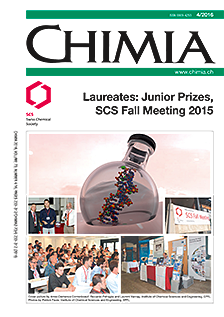Exotic Chemistry with Ultracold Rydberg Atoms
DOI:
https://doi.org/10.2533/chimia.2016.263Keywords:
Dipole-dipole interactions, Long-range rydberg molecules, Rydberg states, Singlet and triplet electron-cs scattering length, Ultracold rydberg gasesAbstract
We review recent experiments carried out with dense (1012 cm–3) ultracold (T = 40 ?K) samples of Cs atoms which have the goal to characterize, by high-resolution spectroscopy, the interactions between Cs atoms, Cs+ ions and electrons that lead to the formation of metastable long-range molecules. The types of molecules observed in these experiments and the mechanisms leading to the aggregation of atoms in weakly bound molecules are very different from those encountered in warmer samples. In particular, we present results on molecules with binding energies of less than 0.05 J/mol and discuss their properties in the context of a new category of molecular states arising from slow-electron–atom scattering and their relation to atomic and molecular Rydberg states. One of the astonishing aspects of these types of molecules is that they can still be treated in good approximation in the realm of the Born-Oppenheimer approximation despite a huge electronic-state density. Non-Born-Oppenheimer effects are revealed by the decay of the molecules into neutral and charged fragments.Downloads
Published
2016-04-27
Issue
Section
Scientific Articles
License
Copyright (c) 2016 Swiss Chemical Society

This work is licensed under a Creative Commons Attribution-NonCommercial 4.0 International License.
How to Cite
[1]
H. Saßmannshausen, J. Deiglmayr, F. Merkt, Chimia 2016, 70, 263, DOI: 10.2533/chimia.2016.263.







